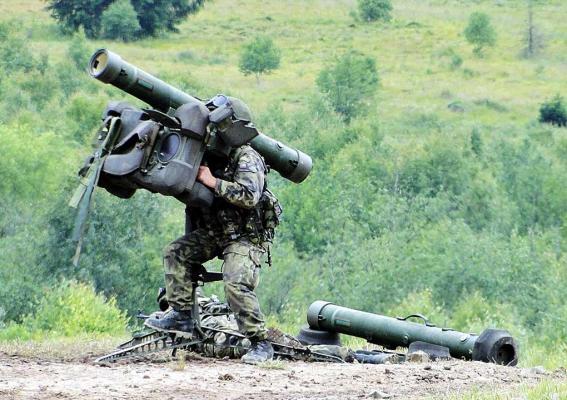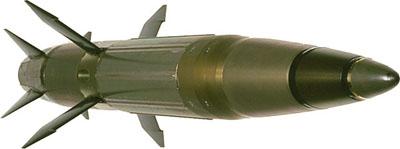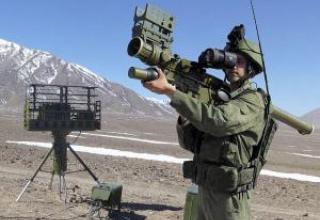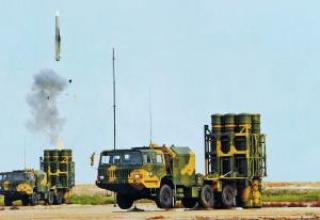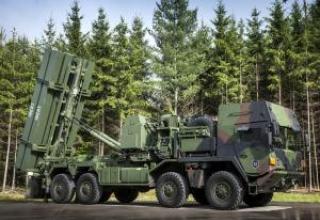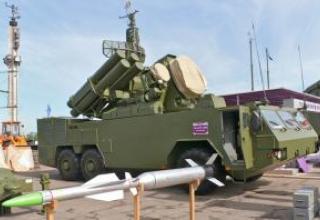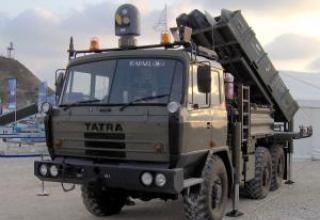The RBS-70 has been designed to meet the requirements of the Swedish Armed Forces, such as long range on the counter course, high accuracy and probability of hitting, resistance to all known artificial and natural interference, the ability to work on targets up to the ground, command control of the sighting line, the possibility of further development for nighttime use. Saab Bofors Dynamic's has chosen the option of pointing the missile through a laser channel. RBS-70 is the world's first man-portable air defense system with such a guidance system. From the very beginning, the complex was created with the prospect of installation on wheeled and tracked chassis.
The works were started in 1967, and seven years later the first samples were tested. In parallel with the fire unit, radio-technical, in particular, radar detection and target designation PS-70/R was also developed. In 1977 the RBS-70 man-portable air defence systems were adopted for service, occupying a niche between the L70 40 mm artillery and Hawk medium range air defense systems. In the Swedish Army RBS-70 man-portable air defence systems were intended to protect the "battalion-mortar" units.
In 1981, the first mobile version of this complex was developed on the basis of the Land Rover vehicle with high cross-country ability. Later RBS-70 was installed on various wheeled and tracked armored vehicles.
Works on improvement of RBS-70 began almost from the moment of its creation. In 1990, the Rb-70 missile was upgraded, resulting in the designation Mk1. The next modification of the SAM system - Mk2 - was adopted in 1993. In early 2001 it was announced that the development of a new missile for the Bolide was completed.
Since 1998, all elements of the complex have been modernized with the introduction of a new data transfer standard to create a single information space for air defense system.
During the existence of the complex about 1500 launchers and more than 15000 missiles of all modifications have been released. Today RBS-70 is in service in Argentina, Australia, Bahrain, Indonesia, Iran, Ireland, Norway, Pakistan, Singapore, Sweden, Thailand, Tunisia, the United Arab Emirates, Venezuela and several other countries. It is used not only in the Army but also in the Air Force, Navy and Marines.
According to Saab Bofors Dynamic's, the total number of missile launches at the end of 2000 was 1468, with more than 90% of the missiles launched hitting targets.
At the international arms exhibition DSEi-2011 in London, an upgraded version of the complex was demonstrated, which was designated RBS-70NG. The complex, equipped with a multi-purpose missile Bolide last generation, is able to withstand a wide range of air and ground threats, including aircraft, helicopters, cruise missiles, UAVs and armored vehicles. The integrated thermal imaging camera and night vision sight allow to hit enemy objects day and night in difficult weather and climate conditions. Three-axis target designation and automatic target detection reduces reaction time, while the automatic tracking system makes it easier for the operator to capture the target and increases the probability of hitting the object at all ranges of the missile.
Composition:
When the Rb-70 missile is launched, it is ejected from a container at a speed of 50m/s. The Rb-70 is then activated, which operates for 6 seconds, accelerating the missile to supersonic speed (M=1.6). The operator's task is to keep the target in sight of the stabilized sight. The laser beam emitted by the guidance unit forms a "corridor" in the centre of which the missile is moving. Low power used by the guidance system and absence of radiation before the missile launch make effective detection of RBS-70 difficult. Command guidance of the missile by the operator increases its interference immunity and allows to hit even energetically maneuvering targets.
Although each launcher can be used independently, the main application option - the RBS-70 in combination with the pulse-doppler radar PS-70 "Giraffe", operating in the range of 5.4-5.9 GHz and provides a range of detection of a typical air target up to 40 km, range of tracking - up to 20 km. The radar antenna rises to a height of 12m on the mast. PS-70 "Giraffe" can be mounted on different chassis, including all-wheel drive three-axle truck Tgb-40, tracked transporter Bv-206 and others. The radar deployment time is not more than 5 minutes. The calculation of the radar consists of five people, providing tracking of three targets in manual mode, while serving up to nine fire calculations.
Information about the targets is sent to the combat control panel, from where it can be directed to specific launchers. In this case, the man-portable air defence systems operator receives target information in the form of an audible signal in headphones, the tone of which depends on the position of the target relative to the launcher. The reaction time of the complex is 4-5s.
A typical operator training course with the simulator takes 15-20 hours distributed over 10-13 days.
Rb-70 missile
ZUR is made according to the normal aerodynamic scheme and is equipped with a two-stage solid fuel marching engine, located in its middle part. There is a BC in the nose section, which can be detonated by laser non-contact or shock fuses. The target is hit by a cumulative charge (armor penetration up to 200 mm) and ready-made tungsten spherical elements. In the tail compartment of the ZUR there are laser radiation receivers.
The last serial version of the ZUR is Rb-70 Mk2. The extended field of view of the laser receiver up to 70° has allowed to expand area of possible capture on 30-40%. Although the missile is equipped with a large-size marching engine and a more efficient combat unit (the number of tungsten balls has increased from two to three thousand, the mass of explosives has increased), thanks to the miniaturization of electronic elements, the dimensions and mass of the LMS remained the same. The range of air targets reached 7 km, the maximum and average flight speed of the missile has increased. The probability of hitting subsonic targets with Rb-70 Mk2 missiles is 0.7-0.9 on counter courses and 0.4-0.5 on catch-up courses (see diagram).
A new Bolide missile for the RBS-70 man-portable air defence system is planned for mass production in 2002. The Bolide man-portable air defence system is a deep modification of the Rb-70 Mk0, Mk1 and Mk2 missiles and is intended for use with existing launchers. The purpose of its creation is to increase the ability of man-portable air defense systems to fight low-visibility and energetically maneuvering targets, such as cruise missiles. The missile has new components: reprogrammable electronics, a fibre optic gyroscope and improved RDTT. The remote detonator has been improved (two modes have been introduced for small and large targets) and the combat unit. The storage period of SAMs in the TIC reaches 15 years. The new fuse does not require a power supply and complies with the MIL-STD-1316E standard.
launcher
The RBS-70 launcher includes:
- SSD in a transport and launch container (weight 24 kg),
- guidance unit (weight 35 kg), consisting of an optical sight (has 7x magnification and 9° field of view) and a laser beam forming device with adjustable focus,
- Identification equipment "alien" (weight 11 kg),
- power supply and tripod (mass 24kg).
It is possible to connect a COND (Clip-on Night Device) thermal imaging camera, which is attached to the launcher, providing the use of man-portable air defence systems in the dark without reducing performance. The thermal imaging camera operates in the wavelength range of 8-12 µm and is equipped with a closed-loop cooling system.
All elements of the RBS-70 man-portable air defense system are located on a tripod, in the upper part of which there is a pointing unit and a container with a ZUR, and in the lower part - the seat of the pointer-operator. Deployment time of the man-portable air handling unit is 10 minutes, recharging time - no more than 30 seconds. For carrying RBS-70 it is enough three people.
Self-propelled options
In many cases, to increase mobility, the RBS-70 was mounted on wheeled or tracked chassis. Thus, the Iranian Army used the Land Rover as a chassis, the Singapore Army used the Kommando V-200 wheeled APC, and in Pakistan - a tracked APC M113A2. Placed on one or another chassis, the RBS-70 can be dismantled in a short time for use as a man-portable air defence system.
The Swedish Armed Forces also used a self-propelled version RBS-70 - Type 701 (Lvrbv 701). The elements of the complex are placed on the chassis of the tracked APC Pbv302. Time of transfer from a camping position to combat - no more than 1 minute. RBS-70 was also used as a ship's air defense system. In the Swedish Navy, for example, they are part of the arms of trawlers type M-80 and patrol boats type "Stirso". The same tripod as the ground version is used as the launcher.
Advantages and disadvantages
Compared to modern man-portable air defense systems with IR/UV SNS ("Stinger", "Needle", "Mistral"), RBS-70 significantly wins in range, especially on counter courses. Its ability to engage targets beyond the range of 4-5 km allows the RBS-70 to provide air defense even when other man-portable air defence systems cannot do so. The main drawback of the system is its large mass (the PU and two SAMs in the MAC "pull" 120 kg). To deliver such a "portable" complex to the required point, one has to use vehicles or mount it on different chassis. It is impossible to use it from the shoulder, to transfer or apply in the field to one person, which is also not always acceptable (this was one of the reasons why the complex lost the tender in South Africa).
The RBS-70 team's way of pointing the SSD gives it its own characteristics. It is the best interference immunity, the ability to effectively fight low flying targets, but at the same time the vulnerability of the calculation and high requirements for its preparation. The operator needs to quickly assess the range to the target, its speed, direction and altitude in order to make a decision about launching the missile. Target tracking takes 10-15 seconds, requiring fast and accurate action under high psychological stress.
The complex's advantages include its relatively low cost - about half the cost of a Stinger man-portable air defence system.
Characteristics:
| Type of RMS | Rb-70Mk0 | Rb-70 Mk1 | Rb-70Mk2 | "Bolide" |
| Year of adoption | 1977 | 1990 | 1993 | 2001 |
| Max. range, m. | 5000 | 5000 | 7000 | 8000 |
| Min. range, m | 200 | 200 | 200 | 250 |
| The ceiling, m | 3000 | 3000 | 4000 | 5000 |
| Max. speed, m/s | 525 | 550 | 580 | 680 |
| UR length, m | 1.32 | 1.32 | 1.32 | 1.32 |
| Diameter of UR, mm | 105 | 105 | 105 | 105 |
| Weight of UR, kg | 15 | 17 | 17 | - |
| Weight, kg / type BC | 1 (О) | - | 1,1 (КО) | 1,1 (КО) |
Testing:
RBS-70 was used in real hostilities only in the military conflict between Iran and Iraq in 1980-88. In the Iranian armed forces, RBS-70 filled the niche between the Chinese version of the Soviet Arrow-2 man-portable air defence systems and the US Hawk medium range man-portable air defence systems. The appearance of RBS-70 on battlefields took place in January-February 1987. The high mobility of these anti-aircraft systems made it possible to organize ambushes on the most probable routes of Iraqi combat aircraft. It is believed that it was RBS-70 that shot down most of the 42 (according to some sources - 45) aircraft lost by Iraq.
Sources:
- Скандинавский страж (Воздушно-космическая оборона)
- Army Technology - Saab Bofors Dynamics AB - Air Defence Missileswww.army-technology.com
- Army Technology - Saab Bofors Dynamics AB - RBS 70 Air Defence Missile Systemwww.army-technology.com
- Bolide SAM will enter production next year
- http://www.armstrade.org/includes/periodics/mainnews/2011/1018/095510017/detail.shtml
